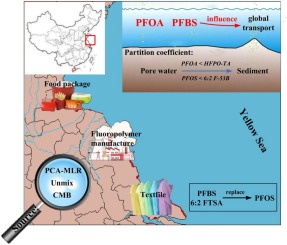当前位置:
X-MOL 学术
›
J. Hazard. Mater.
›
论文详情
Our official English website, www.x-mol.net, welcomes your feedback! (Note: you will need to create a separate account there.)
Potential sources and sediment-pore water partitioning behaviors of emerging per/polyfluoroalkyl substances in the South Yellow Sea.
Journal of Hazardous Materials ( IF 13.6 ) Pub Date : 2020-01-20 , DOI: 10.1016/j.jhazmat.2020.122124 Xuemin Feng 1 , Minqiang Ye 2 , Yao Li 1 , Jian Zhou 3 , Binbin Sun 1 , Yumin Zhu 1 , Lingyan Zhu 1
Journal of Hazardous Materials ( IF 13.6 ) Pub Date : 2020-01-20 , DOI: 10.1016/j.jhazmat.2020.122124 Xuemin Feng 1 , Minqiang Ye 2 , Yao Li 1 , Jian Zhou 3 , Binbin Sun 1 , Yumin Zhu 1 , Lingyan Zhu 1
Affiliation

|
Emerging per/polyfluoroalkyl substances (PFASs) have received great concerns, but there are few data in the coastal environment, which play an essential role in their global transport. In this study, surface water and sediment samples were collected in the South Yellow Sea close to Jiangsu Province China, and 26 legacy as well as emerging PFASs were investigated. Perfluorooctanoic acid (PFOA) and perfluorobutane sulfonate (PFBS) were predominant in the coastal water of the South Yellow Sea with a relatively higher level than other coastal regions in the world. PFBS and 6:2 fuorotelomer sulfonic acid (6:2 FTSA) were two major alternatives of perfluorooctane sulfonate (PFOS) which were used in textile surface treatment and fire-fighting foams, respectively. Multiple receptor models identified that fluoropolymer manufacture, textile and food packages were three major sources of PFASs in the South Yellow Sea. The partitioning behaviors of PFASs between sediment and pore water in the marine environment were compared, and the partitioning coefficients of hexafluoropropylene oxide trimer acid (HFPO-TA) and 6:2 chlorinated polyfluorinated ether sulfonic acid (6:2 F-53B) were reported for the first time, which exhibited stronger partition in sediment than their predecessors. The results provide important hints to understand the environmental transport of PFASs in the marine environment.
更新日期:2020-01-21


























 京公网安备 11010802027423号
京公网安备 11010802027423号